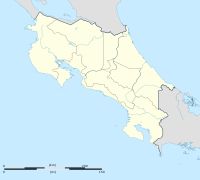Nicoya
| Nicoya | |
|---|---|
| City | |
 |
|
| Location in Costa Rica | |
| Coordinates: 10°09′N 85°27′W / 10.150°N 85.450°WCoordinates: 10°09′N 85°27′W / 10.150°N 85.450°W | |
| Country |
|
| Province | Guanacaste Province |
| Canton | Nicoya Canton |
| Founded | 1523 |
| Joined Republic of Costa Rica | 1824-1825 |
| Government | |
| • Mayor | Eduardo Gutiérrez Rosales |
| Highest elevation | 123 m (404 ft) |
| Lowest elevation | 3 m (10 ft) |
| Population (2013) | |
| • Total | 24,946 |
| Time zone | Central Standard Time (UTC-6) |
Nicoya, a city on the Nicoya Peninsula of the Guanacaste province, Costa Rica, is one of the country's most important tourist zones; it serves as a transport hub to Guanacaste's beaches and national parks. According to the 2000 census, the city's population was 13,334; second in the province only to Liberia. The city is the district seat of a cantón of the same name, which in 2013 had 24,946 residents.
When conquistador Gil Gonzalez Dávila entered Nicoya in 1523, it was the largest cacicazgo (chiefdom) on the Pacific coast of Costa Rica. Though it is often surmised that the city and peninsula of Nicoya derive their name from a cacique Nicoa (or Nicoya) who welcomed Dávila and his men, actually Nicoya took its name from the Nahuatl appellation Necoc Īāuh, literally "on both sides its water(s)", as Nicoya is in fact situated between two major rivers. The Peninsula de Nicoya is itself named for the city, Nicoya being the most important town in that area.
The treasurer on Dávila's expedition, Andrés de Cereceda, reported a population of 6,063 inhabitants under Nicoya's leadership, almost five and a half times larger than the next largest settlement visited by the Spanish along the Pacific coast in the early 1520s. According to 16th-century chronicler Gonzalo Fernández de Oviedo y Valdés who visited Nicoya in 1529, the layout of the indigenous community was similar to that of the larger settlements in nearby Nicaragua and included a central plaza with temples, a low pyramidal mound used for human sacrifice, and specialized plazas for markets and chiefs' residences.
Many of the earliest colonial documents about pre-Columbian Nicoya appear to have been lost in a fire that burned the town's archives in 1783. In the resulting documentary vacuum, a number of interpretations regarding pre-Hispanic Nicoya have emerged. Foremost among them is the belief that as the southernmost representatives of Mesoamerican culture, Nicoyans lived in nucleated villages, and that Cereceda's accounting of 6,063 souls merely represented the number of inhabitants of one village under chief Nicoya's control. The modern city of Nicoya is generally believed to be on the site of that village.
...
Wikipedia

